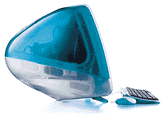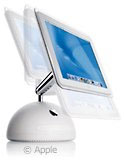My last article, Picking an Older Power Mac:
Go G4, brought up the subject of buying an older Power Mac for
basic, typical modern computing tasks. While Power Macs are very
useful, expandable, and great for those who want to use a large
monitor, they're not what everyone is looking for.
Five years ago, if you wanted an all-in-one Mac, you had to go
with something like the Performa
5400 - unless you didn't mind the 5200 series (which had many inherent
design problems) or the non-PowerPC LC/Performa 500 series.
These days there are some much better options for those looking
for an inexpensive all-in-one computer. For the same $300 that gets
you a 400 MHz PowerMac G4, you can get quite a nice 600 MHz G3 iMac.
I'm not too big a fan of the early iMacs - the ones that use
tray-loading CD-ROM drives. They're slow, not worth upgrading,
somewhat ugly, and have a tendency for the analogue boards to
fail.
They are cheap, though - for around $100 you can get yourself a
decent, working 266 MHz iMac setup. (See This Week's Best iMac G3 Deals.)
You'll be able to run OS X, but only if you don't mind waiting
for the text you type to catch up with you (especially if you're
using more than one application at a time or don't have the maximum
RAM).
 What's next in the line? There were
the 350 MHz blueberry iMacs,
which used the new (much nicer) case design and a slot-loading
CD-ROM drive. All 400 MHz and faster models had built-in FireWire,
so if you plan on going for one of these, be sure you get a model
that has it. If you don't, Apple won't officially support Mac
OS X 10.4.* These are great machines for OS 9, and they
run OS X about as decently as a blue and white G3.
What's next in the line? There were
the 350 MHz blueberry iMacs,
which used the new (much nicer) case design and a slot-loading
CD-ROM drive. All 400 MHz and faster models had built-in FireWire,
so if you plan on going for one of these, be sure you get a model
that has it. If you don't, Apple won't officially support Mac
OS X 10.4.* These are great machines for OS 9, and they
run OS X about as decently as a blue and white G3.
That may not be decent enough for you. The next step in the line
is a 400 MHz iMac. Most 400 MHz iMacs shipped with CD-ROM, but some
have DVD-ROM drives, and they're decent performers with OS X.
They also shipped with the newer Apple Pro keyboard and mouse, so
if you're not planning on buying third-party peripherals, you might
consider one of these machines based on the peripherals that come
with it.
Then again, many times these older machines get resold without
the keyboard and mouse, so that may be irrelevant. The additional
performance in OS X is noticeable over even a 350 MHz
machine.
There was a single 450 MHz
iMac. It included a DVD drive, and it's not nearly as common as
other iMac speeds.
These machines are sometimes available for under $200 these
days, and a 500 MHz CD-RW model is generally available for not much
more.
But if you want something that will be sitting on your desk for
more than six months, you might consider one of the 600 MHz iMacs.
These came with CD-RW drives,* were available in the more subdued
graphite and snow colors, and generally have a more professional
look to them.
The 600 MHz processor as well as the better video card (the
350-450 MHz iMacs had only 8 MB of VRAM with Rage 128
graphics, as did some 500 MHz models; other 500 MHz and all 600-700
MHz models had 16 MB with Rage Ultra 128) will significantly
increase OS X performance - some of these models shipped with
OS X installed. If you go with a 500 MHz iMac, try to find one
with Rage Ultra.
 If you've got a bit more
money to spend, G4 iMacs are
available for under $600. However, unless you really need the
integrated display, it's probably a better idea to simply buy a
$499 Mac mini. It's an amazing
value - you're getting a machine almost twice as fast as the
low-end iMac G4 with all the same features except for the display
(which you may already have from a previous computer).
If you've got a bit more
money to spend, G4 iMacs are
available for under $600. However, unless you really need the
integrated display, it's probably a better idea to simply buy a
$499 Mac mini. It's an amazing
value - you're getting a machine almost twice as fast as the
low-end iMac G4 with all the same features except for the display
(which you may already have from a previous computer).
If you want to keep it under $300, I recommend the 600 MHz iMac.
If not, go with the Mac mini.
* Tiger (Mac OS X 10.4) will ship on DVD. Only the faster 1999
and 2000 iMac models included DVD-ROM drives, so if you want to go
with Tiger, your options are sending the DVD back to Apple with $10
to cover shipping on the CD version or picking up a DVD-ROM, Combo,
or DVD-RW drive (internal or external using FireWire).
ed

 What's next in the line? There were
the
What's next in the line? There were
the  If you've got a bit more
money to spend,
If you've got a bit more
money to spend, 
